
New Energy Automatic Flexible Flat Bare Copper And Aluminum Foil Board Roll Sheet Metal Cutting Machine Cut To Machine










The construction industry has consistently showcased human innovation, with materials evolving to meet the demands of each era. From the use of wood and stone in ancient times to the introduction of bricks and concrete, the industry has undergone significant transformations. Today, we are witnessing another revolution, brought about by the advent of flexible metal sheets. Made from highly malleable and ductile metals like aluminum, brass, and copper, these sheets are pushing the boundaries of construction, offering strength, malleability, and sustainability. This article explores the evolution of construction materials, the properties and advantages of flexible metal sheets, their manufacturing process, applications, and the future of construction with these innovative materials.
The history of construction materials is a testament to human ingenuity. From the use of wood and stone in antiquity, to the introduction of bricks in Mesopotamia and concrete by the Romans, materials have evolved to meet the needs of the times. The Middle Ages saw stone regain prominence, while the Renaissance brought back bricks. The Industrial Revolution introduced metals, notably iron and steel, and reinforced concrete, enabling the construction of the first skyscrapers. Today, the focus is on sustainable, self-supporting, and earthquake-resistant materials, indicating that the evolution of construction materials is far from over.
Flexible metal sheets are derived from highly malleable and ductile metals. Key examples include aluminum, brass, and copper. Aluminum is lightweight and bends easily, making it suitable for various technical applications. Brass, known for its shine and malleability, is used in areas where corrosion and friction resistance is key. Despite being heavy, copper retains significant malleability and ductility, making it perfect for applications ranging from electrical wiring to jewelry. The flexibility of these metals ensures that when they are processed through a bending machine, the final product holds its shape indefinitely.
Flexible metal sheets, often made from materials like steel or aluminum, offer several advantages. They are high in strength, making them ideal for heavy-duty applications. Their malleability allows them to be formed into various shapes, maintaining structural integrity during the fabrication process. Despite their robustness, they are lightweight, advantageous in applications where weight reduction is crucial. They offer design versatility, can be cut, bent, and shaped into complex forms. These sheets are cost-effective, durable, and have high accuracy and precision due to advanced fabrication techniques. They also promote sustainability as they are highly recyclable.
The manufacturing process of flexible metal sheets involves cutting, bending, and forming the metal into specific shapes. Techniques such as rolling, extruding, and bending are used to form the final product. The process also includes deformation methods like bending, stamping, and spinning. Assembly of the components is done using fasteners, screws, and rivets, or through welding. The entire process is a blend of precision and efficiency, crucial for producing high-quality flexible metal sheets.
Flexible metal sheets, such as sheet metal, are extensively used in construction for both exterior and interior applications. Externally, they serve as decorative and functional elements, contributing to the aesthetic appeal and energy efficiency of buildings. They are ideal for stormwater management features like downspouts and gutters due to their weatherproof properties. Internally, they are used in the construction of HVAC and plumbing fixtures, lighting walls, millwork assemblies, wall finishes, and staircases. Their flexibility and durability make them a versatile choice for various construction needs.
A notable case study on the application of flexible metal sheets involves the use of Laser Additive Manufacturing. Researchers Bambach, Sviridov, Weisheit, and Schleifenbaum conducted studies on local reinforcement of sheet metal components using this method. Their work, published in 2017, demonstrated the potential of this technology in enhancing the properties and applications of flexible metal sheets in various industries, including construction. The study highlighted the innovative ways of reinforcing sheet metal components, which could revolutionize the construction industry.
Using flexible metal sheets in construction comes with its own set of challenges. One significant issue is the fluctuating cost of sheet metal materials like steel and aluminum, influenced by global supply and demand, tariffs, and trade disputes. Contractors must constantly adapt to these fluctuations to maintain profitability. Additionally, environmental regulations and sustainability concerns are increasingly important. Contractors must navigate complex compliance requirements related to emissions, waste disposal, and energy efficiency. Technological advancements can improve efficiency in sheet metal fabrication, but keeping up with them can be costly and require ongoing training.
The future of construction with flexible metal sheets looks promising. The global sheet metal market is expected to expand at a compound annual growth rate (CAGR) of 5.0% from 2020 to 2025. The construction sector is projected to grow at an average growth rate of around 4.0% per annum to 2030, stimulating the demand for sheet metal. Technological advancements have made it possible to produce sheet metal using less energy, and the products require less maintenance. The rising importance of steel in the construction industry and infrastructural developments in economies worldwide are expected to drive the market over the forecast period.
Flexible metal sheets are poised to revolutionize the construction industry. Their unique properties of strength, malleability, and sustainability make them an ideal choice for various applications. Despite challenges such as fluctuating costs and environmental regulations, the future of construction with flexible metal sheets looks promising. The global sheet metal market is expected to expand significantly, driven by technological advancements and the rising importance of steel in the construction industry. As we move forward, these flexible metal sheets will continue to redefine the boundaries of construction, ushering in a new era of innovation and sustainability.